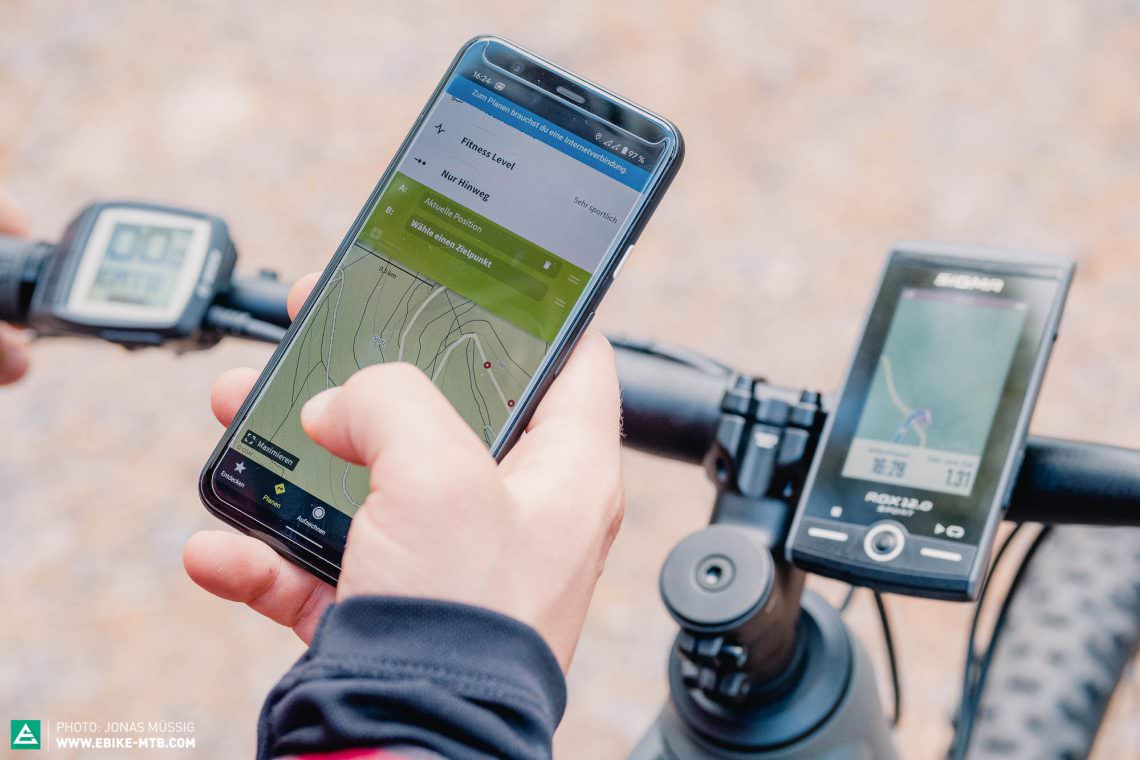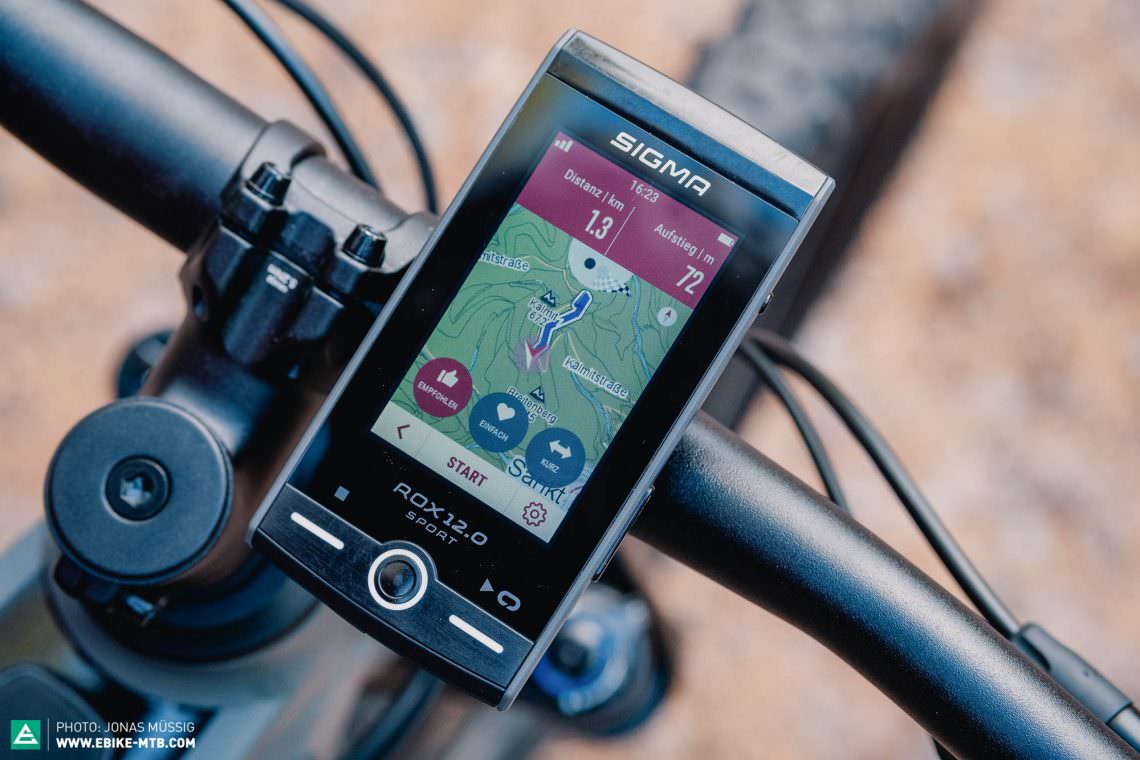The SIGMA ROX 12.0 is the flagship GPS device in SIGMA’s portfolio and it’s been on the market for over 2 years. While the case with its large edge around the screen looks a bit old-fashioned, the maps and the navigation functions have been kept up to date. Can this older model hold its own against the brand new competition or is it time for a successor?
Click here for an overview of the best e-bike navigation device

The SIGMA ROX 12.0 combines good navigation functions with comprehensive fitness tracking features. The ANT+ LEV interface allows it to replace the display of some ebikes.
The SIGMA ROX 12.0 was probably inspired by the first smartphones. As an external device, it can be used on any ebike as well as analogue bikes. In addition to the buttons on the sides and the lower edge, the SIGMA Rox features a 3″ touch screen. It isn’t cheap at € 399 but the only other classic GPS device on test, the Garmin Edge 1030 Plus is significantly more expensive at € 600.


To make the best possible use of navigation with the SIGMA ROX 12.0 you can create different activity profiles on the device, depending on the bike and intended use. For example, you can create one profile for your trekking bike with a preference for cycle paths and one for your eMTB which favours unpaved surfaces.To start navigating, the SIGMA ROX 12.0 offers riders the option of entering an address, selecting a point on the map, even drawing a route on the map by hand or following predefined routes and previously recorded activities. When entering the address, the SIGMA ROX 12.0 can only take you to a street in a town but not the specific house number. If you want to go to the exact address, you’ll have to shift the location pin by hand on the map after entering the street, which isn’t easy on the small touch screen. The route calculation on the SIGMA ROX 12.0 is fast and the GPS calculates even very long distances in less than a minute. The SIGMA offers short, easy and recommended route options. An elevation profile quickly shows the difference between the easy and the short route as the easy route avoids steep climbs. The recommended route is based on the preferences of the selected profile and might take sensible detours to follow marked cycle paths, for example. You’re able to create routes and loops on the device itself, on a PC or a smartphone via the SIGMA Data Center or the likes of Komoot. To synchronise the routes with the SIGMA ROX 12.0, you’ll need a WiFi connection or USB cable connected to a PC since the GPS cannot communicate directly with a smartphone.

If you deviate from a course calculated on the device, the route to your destination will be quickly recalculated. On the other hand, if you’re following a saved route, the SIGMA ROX 12.0 is programmed to quickly guide the rider back to the planned route if you go off course, rather than recalculating it. The GPS determines your location very precisely so that you’ll rarely miss a turn. With clear visual and acoustic navigation instructions, the rider always knows what’s coming up. SIGMA are among the best in this regard and the map is always easy to understand.The display regulates its brightness automatically and remains easy to read even in direct sunlight. Depending on the brightness of the display, the integrated battery can last up to 10 hours. If your ebike has an ANT+ LEV interface, the SIGMA can also display data such as the battery level, remaining range and support mode.


In theory, the ROX 12.0 could replace the main display of an ebike. However, the prerequisite for this is that your eMTB can be used without its main display. This is the case with the latest Shimano motors and some eMTBs from Specialized and Giant. You’ll also be able to link the GPS device with compatible ANT+ and Bluetooth enabled sensors such as heart rate monitors. All data is recorded while riding and can be evaluated afterwards. The SIGMA ROX 12.0 leaves nothing to be desired for fitness freaks. It even offers profiles for other sports such as golf or snowboarding and can be used as a multisport tracker.
Conclusion
Apart from a few minor weaknesses, the SIGMA ROX 12.0 provides good navigation, impressing us most with its simple preference settings and clear display. The operation via the relatively small touchscreen requires a delicate touch and some time to get used to. If your ebike is compatible, it’ll give minimalistic riders all the data they need to replace the main display but, unfortunately, this isn’t (yet) possible with a lot of motors on the market. For € 399, the SIGMA ROX 12.0 is an expensive investment, especially considering the available alternatives.
Tops
- recognises ebike data
- good routing options
- comprehensive fitness functions
Flops
- not compatible with all ebike motors
- can't communicate directly with a smartphone
- no navigation to house numbers
- quirky menu navigation
Find more information here: sigmasport.com.
The Testfeld
Get a quick overview of this test here: The best e-bike navigation device
All navigation devices in the group test: Bosch COBI.Bike Sport (Click for review)| Bosch Nyon (Click for review) | Bosch SmartphoneHub (Click for review) | Garmin Edge 1030 Plus (Click for review) | SIGMA ROX 12.0
Did you enjoy this article? If so, we would be stoked if you decide to support us with a monthly contribution. By becoming a supporter of E-MOUNTAINBIKE, you will help secure a sustainable future for high-quality cycling journalism. Click here to learn more.
Words: Rudolf Fischer Photos: Jonas Müssig









